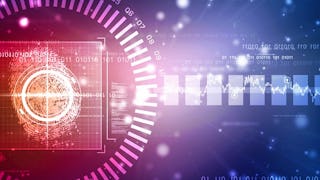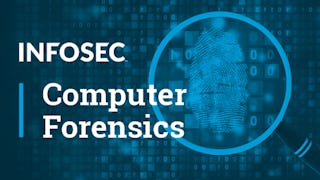The Digital Forensics Essentials (DFE) : Hands-On Edition course provides learners with the skills needed to conduct forensic investigations and analyze digital evidence.



Digital Forensics Essentials: Hands-On Edition
Dieser Kurs ist Teil von Information Security Analyst (berufsbezogenes Zertifikat)

Dozent: EC-Council
Bei  enthalten
enthalten
Was Sie lernen werden
Network forensics fundamentals, event correlation, and network traffic investigation
Data acquisition concepts, types, format, and methodology
Computer forensics investigation process and its phases
Fundamental concepts of computer forensics
Kompetenzen, die Sie erwerben
- Kategorie: Intrusion Detection and Prevention
- Kategorie: Microsoft Windows
- Kategorie: Cyber Attacks
- Kategorie: Data Integrity
- Kategorie: Web Applications
- Kategorie: Email Security
- Kategorie: Mac OS
- Kategorie: Network Analysis
- Kategorie: Network Security
- Kategorie: Event Monitoring
- Kategorie: Data Storage
- Kategorie: Operating Systems
- Kategorie: Threat Detection
- Kategorie: Malware Protection
- Kategorie: File Systems
- Kategorie: Linux
- Kategorie: Cyber Threat Intelligence
- Kategorie: Encryption
- Kategorie: Cybersecurity
- Kategorie: Computer Security Awareness Training
Wichtige Details

Zu Ihrem LinkedIn-Profil hinzufügen
Juli 2025
71 Aufgaben
Erfahren Sie, wie Mitarbeiter führender Unternehmen gefragte Kompetenzen erwerben.

Erweitern Sie Ihr Fachwissen im Bereich Computer Security and Networks
- Lernen Sie neue Konzepte von Branchenexperten
- Gewinnen Sie ein Grundverständnis bestimmter Themen oder Tools
- Erwerben Sie berufsrelevante Kompetenzen durch praktische Projekte
- Erwerben Sie ein Berufszertifikat von EC-Council zur Vorlage

In diesem Kurs gibt es 12 Module
Computer forensics plays a vital role in the investigation and prosecution of cybercriminals. The process includes the acquisition, inspection, and reporting of information stored across computers and networks in relation to a civil or criminal incident. Forensic investigators are trained professionals who extract, analyze/investigate, and report crimes that either target technology or use it as a tool to commit a crime. This module discusses the role of computer forensics in today’s world.
Das ist alles enthalten
8 Videos7 Aufgaben
One of the goals of performing a forensic investigation process is to have a better understanding of an incident by identifying and analyzing the evidence thereof. This module describes the different stages involved in the complete computer forensic investigation process and highlights the role of expert witnesses in solving a cybercrime case. It also outlines the importance of formal investigation reports presented in a court of law during a trial.
Das ist alles enthalten
5 Videos5 Aufgaben1 App-Element
Storage devices such as Hard Disk Drives (HDDs) and Solid-State Drives (SSDs) are an important source of information during forensic investigation. The investigator should locate and protect the data collected from storage devices as evidence. Therefore, it is necessary for the investigator to have knowledge on the structure and behavior of storage devices. The file system is also important as the storage and distribution of the data in a device is dependent on the file system used. This module provides insight into hard disks and file systems.
Das ist alles enthalten
6 Videos6 Aufgaben1 App-Element
Data acquisition is the first proactive step in the forensic investigation process. Forensic data acquisition does not merely entail the copying of files from one device to another. Through forensic data acquisition, investigators aim to extract every bit of information present in the victim system’s memory and storage, in order to create a forensic copy of this information. Further, this forensic copy must be created in a manner such that integrity of the data is verifiably preserved and can be used as evidence in the court. This module discusses the fundamental concepts of data acquisition and the various steps involved in the data acquisition methodology.
Das ist alles enthalten
5 Videos5 Aufgaben1 App-Element
After compromising a system, attackers often try to destroy or hide all traces of their activities; this makes forensic investigation extremely challenging for investigators. The use of various techniques by cyber-criminals to destroy or hide traces of illegal activities and hinder forensic investigation processes are referred to as anti-forensics. Forensic investigators need to overcome/defeat anti-forensics so that an investigation yields concrete and accurate evidence that helps identify and prosecute the perpetrators. This module outlines the fundamentals of anti-forensics techniques and elaborately discusses how forensic investigators can defeat them using various tools.
Das ist alles enthalten
8 Videos8 Aufgaben1 App-Element
Windows forensics refers to investigation of cyber-crimes involving Windows machines. It involves gathering of evidence from a Windows machine so that the perpetrator(s) of a cybercrime can be identified and prosecuted. Windows is one of the most widely used OSes; therefore, the possibility of a Windows machine being involved in an incident is high. So, investigators must have a thorough understanding of the various components of a Windows OS such as the file system, registries, system files, and event logs where they can find data of evidentiary value. This module discusses how to collect and examine forensic evidence related to incidents of cybercrime on Windows machines.
Das ist alles enthalten
5 Videos5 Aufgaben1 App-Element
Windows may be the most commonly used platform for forensic analysis owing to its popularity in enterprise systems. Several digital forensics tools exist for systems operating on Windows. However, when it comes to conducting forensics investigation on Linux and Mac systems, investigators are faced with a different kind of challenge. While the forensics techniques are the same, the tools used might differ. This module discusses how to collect and examine evidence related to incidents of cybercrime on Linux and MacOS–based machines.
Das ist alles enthalten
5 Videos5 Aufgaben1 App-Element
Network forensic investigation refers to the analysis of network security events (which include network attacks and other undesirable events that undermine the security of the network) for two broad purposes — to determine the causes of the network security events so that appropriate safeguards and countermeasures can be adopted, and to gather evidence against the perpetrators of the attack for presentation in the court of law. This module discusses the methods of investigating network traffic to locate suspicious packets and identify indicators of compromise (IoCs) from the analysis of various log files.
Das ist alles enthalten
6 Videos6 Aufgaben1 App-Element
Web applications allow users to access their resources through client-side programs such as web browsers. Some web applications may contain vulnerabilities that allow cyber criminals to launch application-specific attacks such as SQL Injection, cross site scripting, local file inclusion (LFI), command injection, etc., which cause either partial or complete damage of the underlying servers. Moreover, such attacks against web applications can lead to massive financial and reputational damage for organizations. In most cases, organizations are unable to trace the root cause of an attack, which leaves security loopholes for the attackers to exploit. This is where web application forensics assumes significance. This module discusses the procedure of web application forensics, various types of attacks on web servers and applications, and where to look for evidence during an investigation. Furthermore, it explains how to detect and investigate various types of web-based attacks.
Das ist alles enthalten
6 Videos6 Aufgaben1 App-Element
The web has three layers: the surface web, the deep web, and the dark web. While the surface web and deep web are used for legitimate purposes, the dark web is mostly used by cyber criminals to perpetrate nefarious/antisocial activities. Access to the dark web requires the use of the Tor browser, which provides users with a high level of anonymity through a complex mechanism, thereby allowing criminals to hide their identities. This module outlines the fundamentals of dark web forensics, describes the workings of the Tor browser, and discusses steps to perform forensic investigation of the Tor browser.
Das ist alles enthalten
5 Videos5 Aufgaben1 App-Element
Over the past few decades, email services have been extensively used for communication all over the world for exchanging texts and multimedia messages. However, this has also made email a powerful tool for cybercriminals to spread malicious messages and perform illegal activities. The current module intends to familiarize you with the subject of email crimes and how they occur. It primarily focuses on the steps an investigator needs to follow in an email crime investigation.
Das ist alles enthalten
5 Videos5 Aufgaben1 App-Element
Currently, malicious software, commonly called malware, is the most efficient tool for compromising the security of a computer or any other electronic device connected to the internet. This has become a menace owing to the rapid progress in technologies such as easy encryption and data-hiding techniques. Malware is the major source of various cyber-attacks and internet security threats; therefore, computer forensic analysts need to have the expertise to deal with them. This module elaborately discusses the different types of malware, malware forensics fundamentals, and different types of malware analysis that investigators can perform to examine the malicious code and determine how the malware interacts with the system resources and the network during the runtime.
Das ist alles enthalten
8 Videos8 Aufgaben2 App-Elemente
Erwerben Sie ein Karrierezertifikat.
Fügen Sie dieses Zeugnis Ihrem LinkedIn-Profil, Lebenslauf oder CV hinzu. Teilen Sie sie in Social Media und in Ihrer Leistungsbeurteilung.
Dozent

von
Mehr von Computer Security and Networks entdecken
 Status: Kostenloser Testzeitraum
Status: Kostenloser TestzeitraumEC-Council
 Status: Kostenloser Testzeitraum
Status: Kostenloser TestzeitraumInfosec
 Status: Kostenloser Testzeitraum
Status: Kostenloser TestzeitraumInfosec
Warum entscheiden sich Menschen für Coursera für ihre Karriere?





Neue Karrieremöglichkeiten mit Coursera Plus
Unbegrenzter Zugang zu 10,000+ Weltklasse-Kursen, praktischen Projekten und berufsqualifizierenden Zertifikatsprogrammen - alles in Ihrem Abonnement enthalten
Bringen Sie Ihre Karriere mit einem Online-Abschluss voran.
Erwerben Sie einen Abschluss von erstklassigen Universitäten – 100 % online
Schließen Sie sich mehr als 3.400 Unternehmen in aller Welt an, die sich für Coursera for Business entschieden haben.
Schulen Sie Ihre Mitarbeiter*innen, um sich in der digitalen Wirtschaft zu behaupten.
Häufig gestellte Fragen
Yes, you can preview the first video and view the syllabus before you enroll. You must purchase the course to access content not included in the preview.
If you decide to enroll in the course before the session start date, you will have access to all of the lecture videos and readings for the course. You’ll be able to submit assignments once the session starts.
Once you enroll and your session begins, you will have access to all videos and other resources, including reading items and the course discussion forum. You’ll be able to view and submit practice assessments, and complete required graded assignments to earn a grade and a Course Certificate.
Weitere Fragen
Finanzielle Unterstützung verfügbar,


